Alternative Community Justice Strategies: Neighborhood Justice System
VerifiedAdded on 2023/04/07
|10
|1920
|243
Essay
AI Summary
This essay analyzes the Neighborhood Justice System (NJS) in Australia, established in 2007, which combines social and criminal justice to improve community living conditions. The NJS employs restorative practices and alliances with various entities like businesses and schools. It provides services such as mediation, drug treatment, and mental health support. The essay includes a SWOT analysis of the Australian Criminal Intelligence Commission (ACIC), highlighting its strengths in crime reduction and information sharing, and weaknesses in information publication. Opportunities for ACIC include expanding services and improving decision-making, while threats involve social and political hindrances. The essay references various sources and concludes that ACIC is an alternative approach that can resolve issues of crime.

STUDENT NAME:
STUDENT ID:
TOPIC:
DATE:
STUDENT ID:
TOPIC:
DATE:
Paraphrase This Document
Need a fresh take? Get an instant paraphrase of this document with our AI Paraphraser
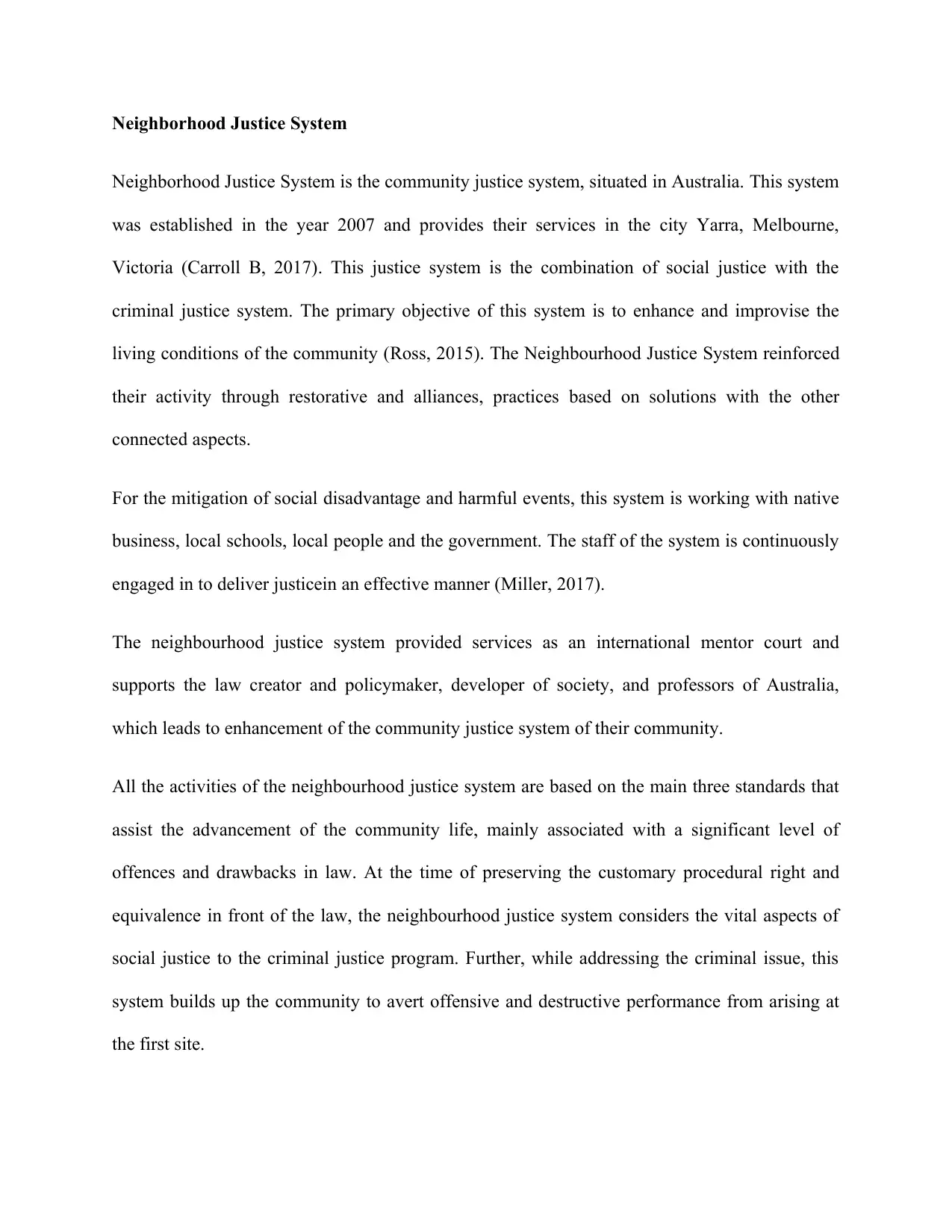
Neighborhood Justice System
Neighborhood Justice System is the community justice system, situated in Australia. This system
was established in the year 2007 and provides their services in the city Yarra, Melbourne,
Victoria (Carroll B, 2017). This justice system is the combination of social justice with the
criminal justice system. The primary objective of this system is to enhance and improvise the
living conditions of the community (Ross, 2015). The Neighbourhood Justice System reinforced
their activity through restorative and alliances, practices based on solutions with the other
connected aspects.
For the mitigation of social disadvantage and harmful events, this system is working with native
business, local schools, local people and the government. The staff of the system is continuously
engaged in to deliver justicein an effective manner (Miller, 2017).
The neighbourhood justice system provided services as an international mentor court and
supports the law creator and policymaker, developer of society, and professors of Australia,
which leads to enhancement of the community justice system of their community.
All the activities of the neighbourhood justice system are based on the main three standards that
assist the advancement of the community life, mainly associated with a significant level of
offences and drawbacks in law. At the time of preserving the customary procedural right and
equivalence in front of the law, the neighbourhood justice system considers the vital aspects of
social justice to the criminal justice program. Further, while addressing the criminal issue, this
system builds up the community to avert offensive and destructive performance from arising at
the first site.
Neighborhood Justice System is the community justice system, situated in Australia. This system
was established in the year 2007 and provides their services in the city Yarra, Melbourne,
Victoria (Carroll B, 2017). This justice system is the combination of social justice with the
criminal justice system. The primary objective of this system is to enhance and improvise the
living conditions of the community (Ross, 2015). The Neighbourhood Justice System reinforced
their activity through restorative and alliances, practices based on solutions with the other
connected aspects.
For the mitigation of social disadvantage and harmful events, this system is working with native
business, local schools, local people and the government. The staff of the system is continuously
engaged in to deliver justicein an effective manner (Miller, 2017).
The neighbourhood justice system provided services as an international mentor court and
supports the law creator and policymaker, developer of society, and professors of Australia,
which leads to enhancement of the community justice system of their community.
All the activities of the neighbourhood justice system are based on the main three standards that
assist the advancement of the community life, mainly associated with a significant level of
offences and drawbacks in law. At the time of preserving the customary procedural right and
equivalence in front of the law, the neighbourhood justice system considers the vital aspects of
social justice to the criminal justice program. Further, while addressing the criminal issue, this
system builds up the community to avert offensive and destructive performance from arising at
the first site.
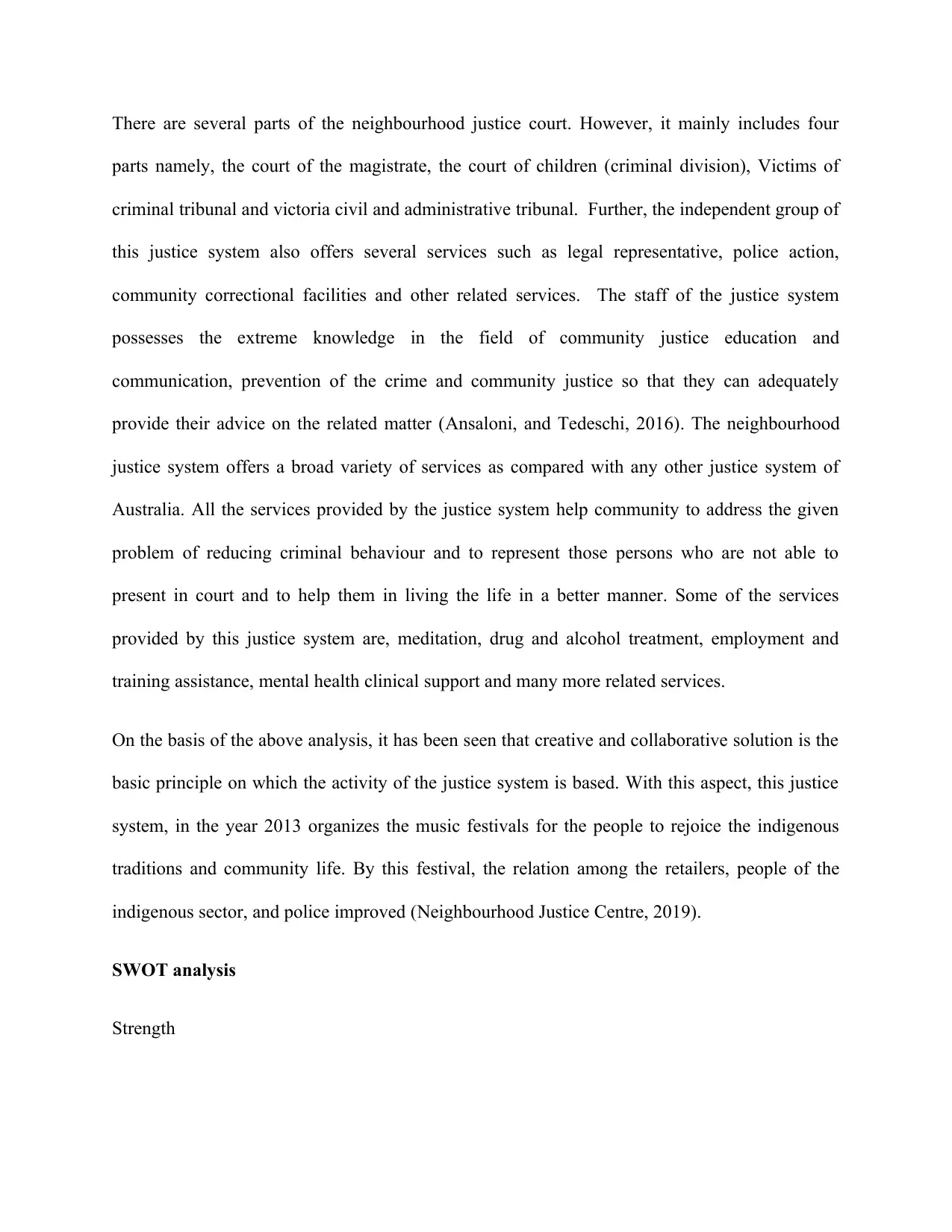
There are several parts of the neighbourhood justice court. However, it mainly includes four
parts namely, the court of the magistrate, the court of children (criminal division), Victims of
criminal tribunal and victoria civil and administrative tribunal. Further, the independent group of
this justice system also offers several services such as legal representative, police action,
community correctional facilities and other related services. The staff of the justice system
possesses the extreme knowledge in the field of community justice education and
communication, prevention of the crime and community justice so that they can adequately
provide their advice on the related matter (Ansaloni, and Tedeschi, 2016). The neighbourhood
justice system offers a broad variety of services as compared with any other justice system of
Australia. All the services provided by the justice system help community to address the given
problem of reducing criminal behaviour and to represent those persons who are not able to
present in court and to help them in living the life in a better manner. Some of the services
provided by this justice system are, meditation, drug and alcohol treatment, employment and
training assistance, mental health clinical support and many more related services.
On the basis of the above analysis, it has been seen that creative and collaborative solution is the
basic principle on which the activity of the justice system is based. With this aspect, this justice
system, in the year 2013 organizes the music festivals for the people to rejoice the indigenous
traditions and community life. By this festival, the relation among the retailers, people of the
indigenous sector, and police improved (Neighbourhood Justice Centre, 2019).
SWOT analysis
Strength
parts namely, the court of the magistrate, the court of children (criminal division), Victims of
criminal tribunal and victoria civil and administrative tribunal. Further, the independent group of
this justice system also offers several services such as legal representative, police action,
community correctional facilities and other related services. The staff of the justice system
possesses the extreme knowledge in the field of community justice education and
communication, prevention of the crime and community justice so that they can adequately
provide their advice on the related matter (Ansaloni, and Tedeschi, 2016). The neighbourhood
justice system offers a broad variety of services as compared with any other justice system of
Australia. All the services provided by the justice system help community to address the given
problem of reducing criminal behaviour and to represent those persons who are not able to
present in court and to help them in living the life in a better manner. Some of the services
provided by this justice system are, meditation, drug and alcohol treatment, employment and
training assistance, mental health clinical support and many more related services.
On the basis of the above analysis, it has been seen that creative and collaborative solution is the
basic principle on which the activity of the justice system is based. With this aspect, this justice
system, in the year 2013 organizes the music festivals for the people to rejoice the indigenous
traditions and community life. By this festival, the relation among the retailers, people of the
indigenous sector, and police improved (Neighbourhood Justice Centre, 2019).
SWOT analysis
Strength
⊘ This is a preview!⊘
Do you want full access?
Subscribe today to unlock all pages.

Trusted by 1+ million students worldwide

Australian criminal intelligence system is responsible to strengthen the response of crime that
affect in Australia. These investigative capabilities maintains the information sharing solutions.
The strength of ACIC is to reduce the crime and stop the criminals exploiting emerging
opportunities (Simpson 2015). The criminal system includes representatives of common wealth,
territory law enforcement and regulatory agencies. There is a strategic direction that tends to
determine the special investigations and operations to control the crime rate in Australia
(Indermaur 2012). The system is subject to jurisdiction and is tasked to prevent and investigate
the law enforcement corruption issues. With the amalgamation of ACC that is Australian Crime
Commission, the change in the historical roots have been observed in NCA National Crime
Authority. The current system of Neighborhood justice system affects high recidivism rate and
has a traditional approach that considers the marginalization of victims. The segregation of
offenders and the community consideration leads to an alternative approach that best suits the
criminal justice system (Australian Criminal Intelligence Management Strategy 2015). Working
on ACIC program, it is possible to accept the modern approach than to work on traditional
system with a limited concern of justice in the society. ACIC is a broader approach which is
systematic and is acceptable with several advantage in reducing the crime rate in the society. The
research programs are unique that achieves a national intelligence picture of crime.
Weakness
There are limitations that are observed in the alternative approach that is ACIC. The Australian
Criminal Intelligence Commission provides Freedom of information. However, the system does
not publish the freedom of information that is required by ACC Australian Crime Commission.
Thereby, the limitations of providing information to a certain extent lead to proactive disclosure
and the required information publication scheme is managed accordingly (Gooda, Priday &
affect in Australia. These investigative capabilities maintains the information sharing solutions.
The strength of ACIC is to reduce the crime and stop the criminals exploiting emerging
opportunities (Simpson 2015). The criminal system includes representatives of common wealth,
territory law enforcement and regulatory agencies. There is a strategic direction that tends to
determine the special investigations and operations to control the crime rate in Australia
(Indermaur 2012). The system is subject to jurisdiction and is tasked to prevent and investigate
the law enforcement corruption issues. With the amalgamation of ACC that is Australian Crime
Commission, the change in the historical roots have been observed in NCA National Crime
Authority. The current system of Neighborhood justice system affects high recidivism rate and
has a traditional approach that considers the marginalization of victims. The segregation of
offenders and the community consideration leads to an alternative approach that best suits the
criminal justice system (Australian Criminal Intelligence Management Strategy 2015). Working
on ACIC program, it is possible to accept the modern approach than to work on traditional
system with a limited concern of justice in the society. ACIC is a broader approach which is
systematic and is acceptable with several advantage in reducing the crime rate in the society. The
research programs are unique that achieves a national intelligence picture of crime.
Weakness
There are limitations that are observed in the alternative approach that is ACIC. The Australian
Criminal Intelligence Commission provides Freedom of information. However, the system does
not publish the freedom of information that is required by ACC Australian Crime Commission.
Thereby, the limitations of providing information to a certain extent lead to proactive disclosure
and the required information publication scheme is managed accordingly (Gooda, Priday &
Paraphrase This Document
Need a fresh take? Get an instant paraphrase of this document with our AI Paraphraser
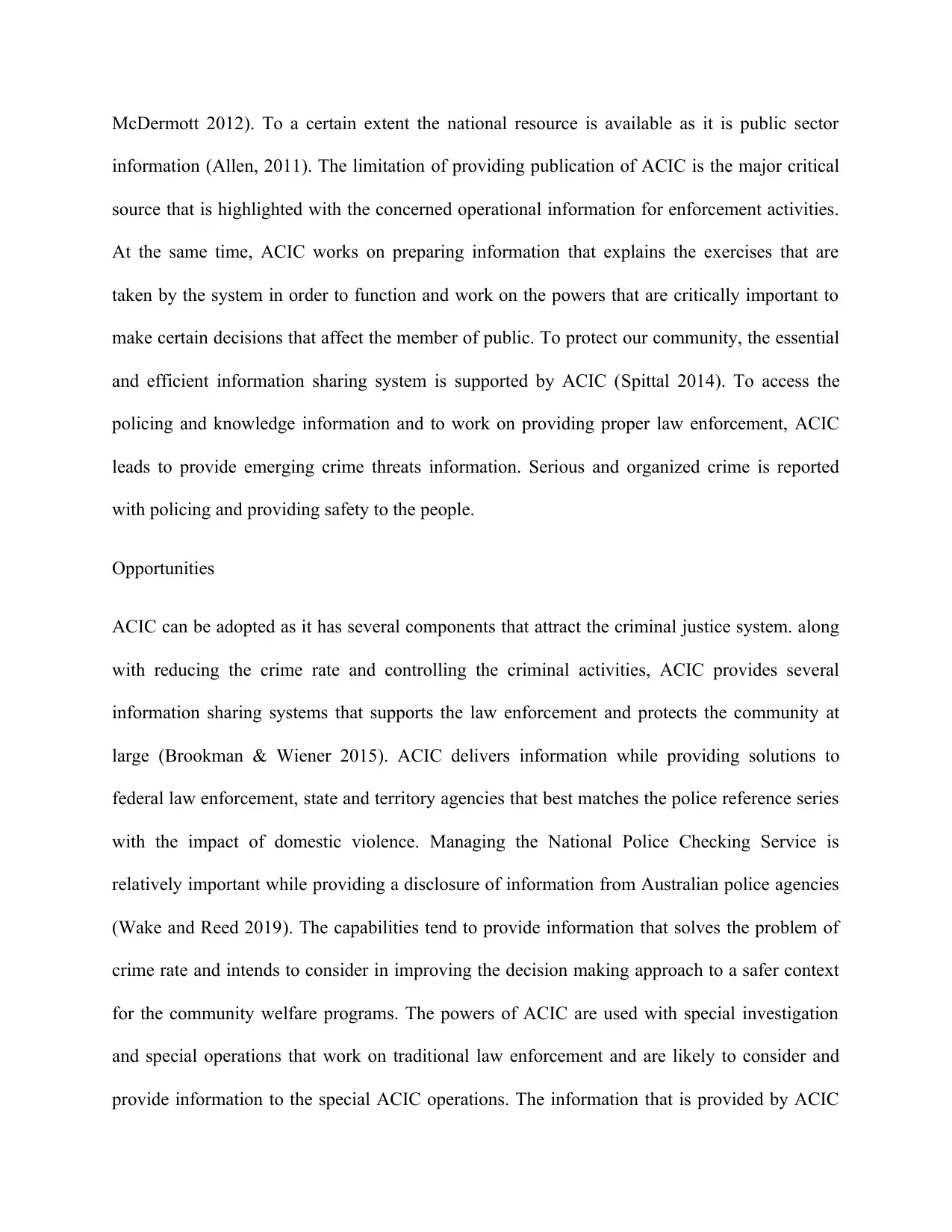
McDermott 2012). To a certain extent the national resource is available as it is public sector
information (Allen, 2011). The limitation of providing publication of ACIC is the major critical
source that is highlighted with the concerned operational information for enforcement activities.
At the same time, ACIC works on preparing information that explains the exercises that are
taken by the system in order to function and work on the powers that are critically important to
make certain decisions that affect the member of public. To protect our community, the essential
and efficient information sharing system is supported by ACIC (Spittal 2014). To access the
policing and knowledge information and to work on providing proper law enforcement, ACIC
leads to provide emerging crime threats information. Serious and organized crime is reported
with policing and providing safety to the people.
Opportunities
ACIC can be adopted as it has several components that attract the criminal justice system. along
with reducing the crime rate and controlling the criminal activities, ACIC provides several
information sharing systems that supports the law enforcement and protects the community at
large (Brookman & Wiener 2015). ACIC delivers information while providing solutions to
federal law enforcement, state and territory agencies that best matches the police reference series
with the impact of domestic violence. Managing the National Police Checking Service is
relatively important while providing a disclosure of information from Australian police agencies
(Wake and Reed 2019). The capabilities tend to provide information that solves the problem of
crime rate and intends to consider in improving the decision making approach to a safer context
for the community welfare programs. The powers of ACIC are used with special investigation
and special operations that work on traditional law enforcement and are likely to consider and
provide information to the special ACIC operations. The information that is provided by ACIC
information (Allen, 2011). The limitation of providing publication of ACIC is the major critical
source that is highlighted with the concerned operational information for enforcement activities.
At the same time, ACIC works on preparing information that explains the exercises that are
taken by the system in order to function and work on the powers that are critically important to
make certain decisions that affect the member of public. To protect our community, the essential
and efficient information sharing system is supported by ACIC (Spittal 2014). To access the
policing and knowledge information and to work on providing proper law enforcement, ACIC
leads to provide emerging crime threats information. Serious and organized crime is reported
with policing and providing safety to the people.
Opportunities
ACIC can be adopted as it has several components that attract the criminal justice system. along
with reducing the crime rate and controlling the criminal activities, ACIC provides several
information sharing systems that supports the law enforcement and protects the community at
large (Brookman & Wiener 2015). ACIC delivers information while providing solutions to
federal law enforcement, state and territory agencies that best matches the police reference series
with the impact of domestic violence. Managing the National Police Checking Service is
relatively important while providing a disclosure of information from Australian police agencies
(Wake and Reed 2019). The capabilities tend to provide information that solves the problem of
crime rate and intends to consider in improving the decision making approach to a safer context
for the community welfare programs. The powers of ACIC are used with special investigation
and special operations that work on traditional law enforcement and are likely to consider and
provide information to the special ACIC operations. The information that is provided by ACIC
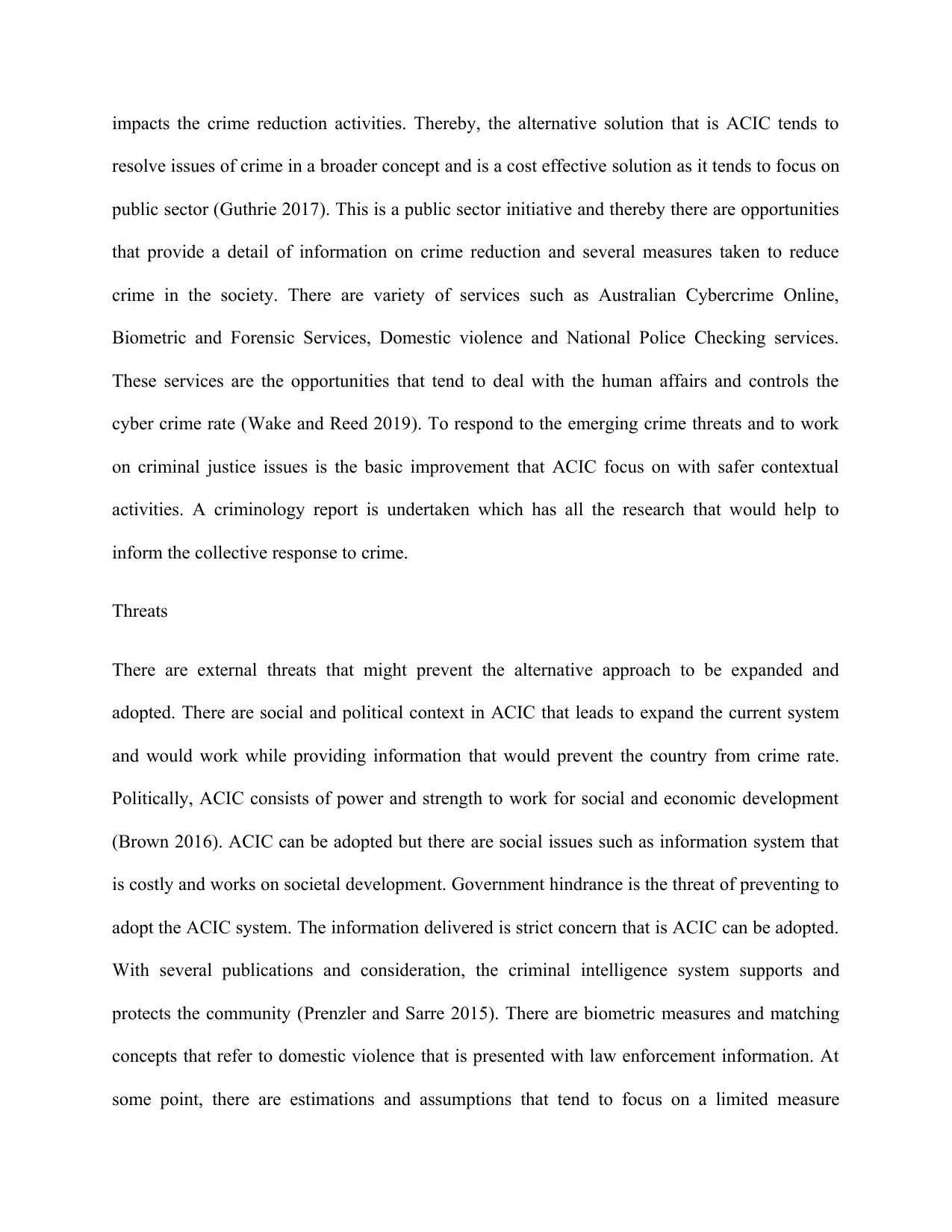
impacts the crime reduction activities. Thereby, the alternative solution that is ACIC tends to
resolve issues of crime in a broader concept and is a cost effective solution as it tends to focus on
public sector (Guthrie 2017). This is a public sector initiative and thereby there are opportunities
that provide a detail of information on crime reduction and several measures taken to reduce
crime in the society. There are variety of services such as Australian Cybercrime Online,
Biometric and Forensic Services, Domestic violence and National Police Checking services.
These services are the opportunities that tend to deal with the human affairs and controls the
cyber crime rate (Wake and Reed 2019). To respond to the emerging crime threats and to work
on criminal justice issues is the basic improvement that ACIC focus on with safer contextual
activities. A criminology report is undertaken which has all the research that would help to
inform the collective response to crime.
Threats
There are external threats that might prevent the alternative approach to be expanded and
adopted. There are social and political context in ACIC that leads to expand the current system
and would work while providing information that would prevent the country from crime rate.
Politically, ACIC consists of power and strength to work for social and economic development
(Brown 2016). ACIC can be adopted but there are social issues such as information system that
is costly and works on societal development. Government hindrance is the threat of preventing to
adopt the ACIC system. The information delivered is strict concern that is ACIC can be adopted.
With several publications and consideration, the criminal intelligence system supports and
protects the community (Prenzler and Sarre 2015). There are biometric measures and matching
concepts that refer to domestic violence that is presented with law enforcement information. At
some point, there are estimations and assumptions that tend to focus on a limited measure
resolve issues of crime in a broader concept and is a cost effective solution as it tends to focus on
public sector (Guthrie 2017). This is a public sector initiative and thereby there are opportunities
that provide a detail of information on crime reduction and several measures taken to reduce
crime in the society. There are variety of services such as Australian Cybercrime Online,
Biometric and Forensic Services, Domestic violence and National Police Checking services.
These services are the opportunities that tend to deal with the human affairs and controls the
cyber crime rate (Wake and Reed 2019). To respond to the emerging crime threats and to work
on criminal justice issues is the basic improvement that ACIC focus on with safer contextual
activities. A criminology report is undertaken which has all the research that would help to
inform the collective response to crime.
Threats
There are external threats that might prevent the alternative approach to be expanded and
adopted. There are social and political context in ACIC that leads to expand the current system
and would work while providing information that would prevent the country from crime rate.
Politically, ACIC consists of power and strength to work for social and economic development
(Brown 2016). ACIC can be adopted but there are social issues such as information system that
is costly and works on societal development. Government hindrance is the threat of preventing to
adopt the ACIC system. The information delivered is strict concern that is ACIC can be adopted.
With several publications and consideration, the criminal intelligence system supports and
protects the community (Prenzler and Sarre 2015). There are biometric measures and matching
concepts that refer to domestic violence that is presented with law enforcement information. At
some point, there are estimations and assumptions that tend to focus on a limited measure
⊘ This is a preview!⊘
Do you want full access?
Subscribe today to unlock all pages.

Trusted by 1+ million students worldwide

(Austin 2013). The government hindrance is a threat, while support of government would impact
the economy and tend to consider strategic operations on a large scale.
the economy and tend to consider strategic operations on a large scale.
Paraphrase This Document
Need a fresh take? Get an instant paraphrase of this document with our AI Paraphraser
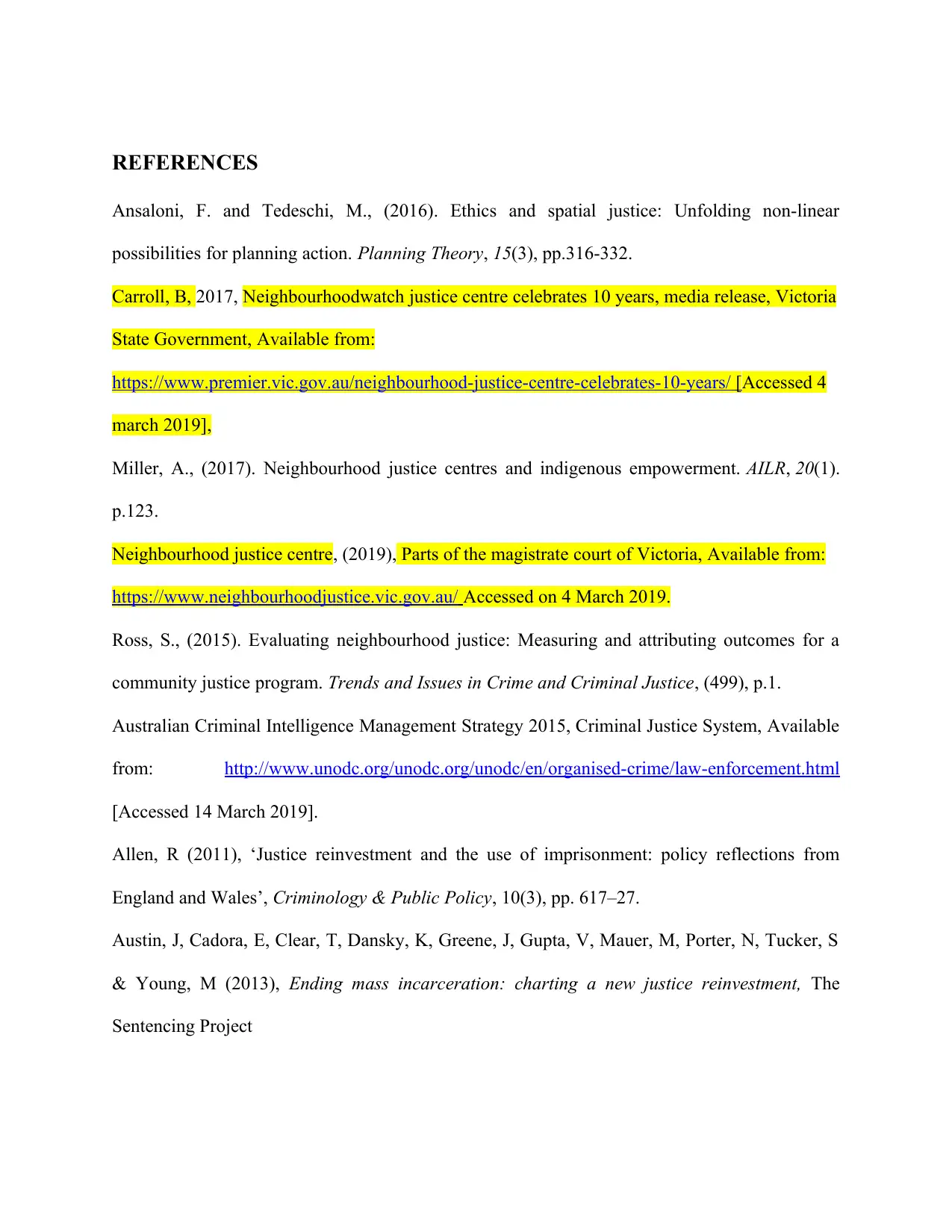
REFERENCES
Ansaloni, F. and Tedeschi, M., (2016). Ethics and spatial justice: Unfolding non-linear
possibilities for planning action. Planning Theory, 15(3), pp.316-332.
Carroll, B, 2017, Neighbourhoodwatch justice centre celebrates 10 years, media release, Victoria
State Government, Available from:
https://www.premier.vic.gov.au/neighbourhood-justice-centre-celebrates-10-years/ [Accessed 4
march 2019],
Miller, A., (2017). Neighbourhood justice centres and indigenous empowerment. AILR, 20(1).
p.123.
Neighbourhood justice centre, (2019), Parts of the magistrate court of Victoria, Available from:
https://www.neighbourhoodjustice.vic.gov.au/ Accessed on 4 March 2019.
Ross, S., (2015). Evaluating neighbourhood justice: Measuring and attributing outcomes for a
community justice program. Trends and Issues in Crime and Criminal Justice, (499), p.1.
Australian Criminal Intelligence Management Strategy 2015, Criminal Justice System, Available
from: http://www.unodc.org/unodc.org/unodc/en/organised-crime/law-enforcement.html
[Accessed 14 March 2019].
Allen, R (2011), ‘Justice reinvestment and the use of imprisonment: policy reflections from
England and Wales’, Criminology & Public Policy, 10(3), pp. 617–27.
Austin, J, Cadora, E, Clear, T, Dansky, K, Greene, J, Gupta, V, Mauer, M, Porter, N, Tucker, S
& Young, M (2013), Ending mass incarceration: charting a new justice reinvestment, The
Sentencing Project
Ansaloni, F. and Tedeschi, M., (2016). Ethics and spatial justice: Unfolding non-linear
possibilities for planning action. Planning Theory, 15(3), pp.316-332.
Carroll, B, 2017, Neighbourhoodwatch justice centre celebrates 10 years, media release, Victoria
State Government, Available from:
https://www.premier.vic.gov.au/neighbourhood-justice-centre-celebrates-10-years/ [Accessed 4
march 2019],
Miller, A., (2017). Neighbourhood justice centres and indigenous empowerment. AILR, 20(1).
p.123.
Neighbourhood justice centre, (2019), Parts of the magistrate court of Victoria, Available from:
https://www.neighbourhoodjustice.vic.gov.au/ Accessed on 4 March 2019.
Ross, S., (2015). Evaluating neighbourhood justice: Measuring and attributing outcomes for a
community justice program. Trends and Issues in Crime and Criminal Justice, (499), p.1.
Australian Criminal Intelligence Management Strategy 2015, Criminal Justice System, Available
from: http://www.unodc.org/unodc.org/unodc/en/organised-crime/law-enforcement.html
[Accessed 14 March 2019].
Allen, R (2011), ‘Justice reinvestment and the use of imprisonment: policy reflections from
England and Wales’, Criminology & Public Policy, 10(3), pp. 617–27.
Austin, J, Cadora, E, Clear, T, Dansky, K, Greene, J, Gupta, V, Mauer, M, Porter, N, Tucker, S
& Young, M (2013), Ending mass incarceration: charting a new justice reinvestment, The
Sentencing Project
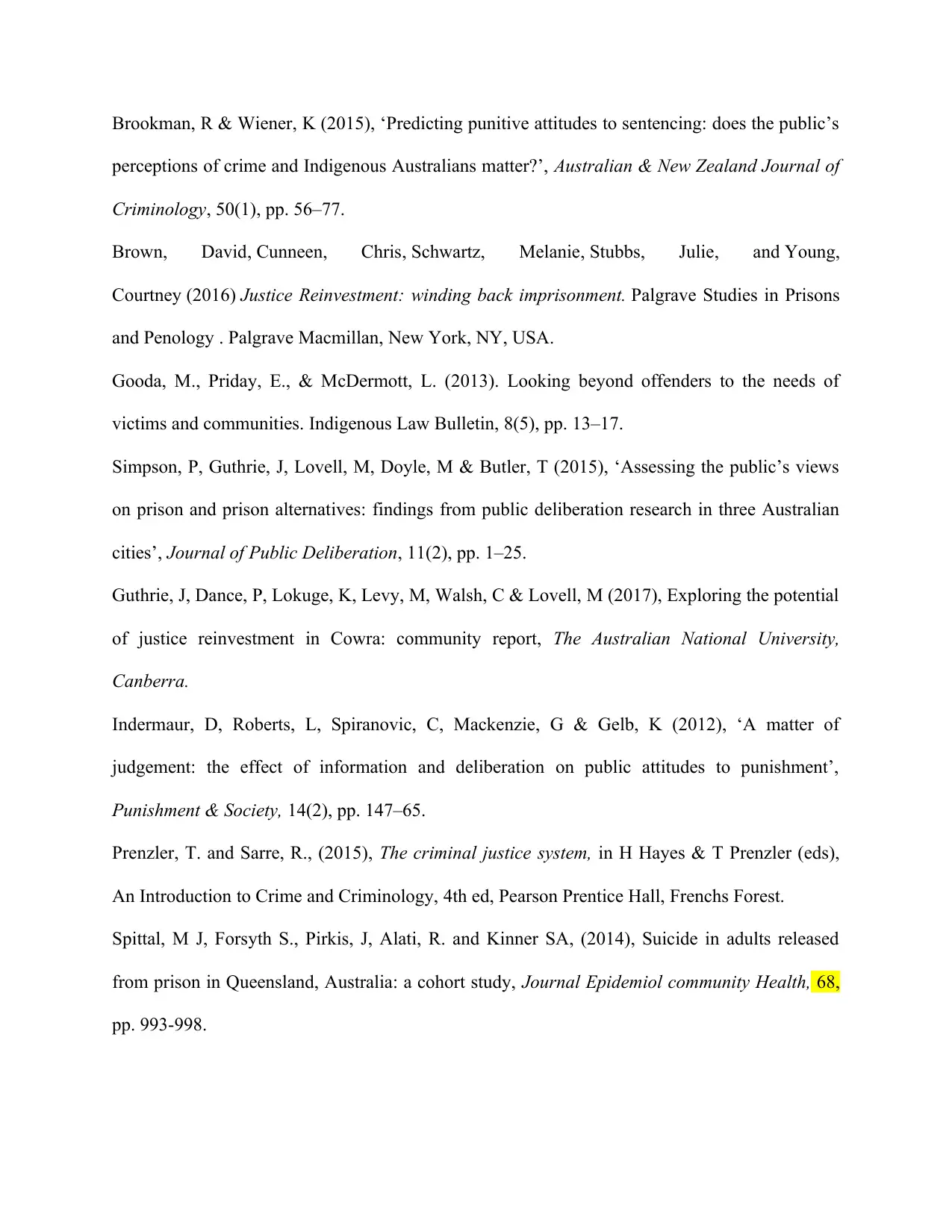
Brookman, R & Wiener, K (2015), ‘Predicting punitive attitudes to sentencing: does the public’s
perceptions of crime and Indigenous Australians matter?’, Australian & New Zealand Journal of
Criminology, 50(1), pp. 56–77.
Brown, David, Cunneen, Chris, Schwartz, Melanie, Stubbs, Julie, and Young,
Courtney (2016) Justice Reinvestment: winding back imprisonment. Palgrave Studies in Prisons
and Penology . Palgrave Macmillan, New York, NY, USA.
Gooda, M., Priday, E., & McDermott, L. (2013). Looking beyond offenders to the needs of
victims and communities. Indigenous Law Bulletin, 8(5), pp. 13–17.
Simpson, P, Guthrie, J, Lovell, M, Doyle, M & Butler, T (2015), ‘Assessing the public’s views
on prison and prison alternatives: findings from public deliberation research in three Australian
cities’, Journal of Public Deliberation, 11(2), pp. 1–25.
Guthrie, J, Dance, P, Lokuge, K, Levy, M, Walsh, C & Lovell, M (2017), Exploring the potential
of justice reinvestment in Cowra: community report, The Australian National University,
Canberra.
Indermaur, D, Roberts, L, Spiranovic, C, Mackenzie, G & Gelb, K (2012), ‘A matter of
judgement: the effect of information and deliberation on public attitudes to punishment’,
Punishment & Society, 14(2), pp. 147–65.
Prenzler, T. and Sarre, R., (2015), The criminal justice system, in H Hayes & T Prenzler (eds),
An Introduction to Crime and Criminology, 4th ed, Pearson Prentice Hall, Frenchs Forest.
Spittal, M J, Forsyth S., Pirkis, J, Alati, R. and Kinner SA, (2014), Suicide in adults released
from prison in Queensland, Australia: a cohort study, Journal Epidemiol community Health, 68,
pp. 993-998.
perceptions of crime and Indigenous Australians matter?’, Australian & New Zealand Journal of
Criminology, 50(1), pp. 56–77.
Brown, David, Cunneen, Chris, Schwartz, Melanie, Stubbs, Julie, and Young,
Courtney (2016) Justice Reinvestment: winding back imprisonment. Palgrave Studies in Prisons
and Penology . Palgrave Macmillan, New York, NY, USA.
Gooda, M., Priday, E., & McDermott, L. (2013). Looking beyond offenders to the needs of
victims and communities. Indigenous Law Bulletin, 8(5), pp. 13–17.
Simpson, P, Guthrie, J, Lovell, M, Doyle, M & Butler, T (2015), ‘Assessing the public’s views
on prison and prison alternatives: findings from public deliberation research in three Australian
cities’, Journal of Public Deliberation, 11(2), pp. 1–25.
Guthrie, J, Dance, P, Lokuge, K, Levy, M, Walsh, C & Lovell, M (2017), Exploring the potential
of justice reinvestment in Cowra: community report, The Australian National University,
Canberra.
Indermaur, D, Roberts, L, Spiranovic, C, Mackenzie, G & Gelb, K (2012), ‘A matter of
judgement: the effect of information and deliberation on public attitudes to punishment’,
Punishment & Society, 14(2), pp. 147–65.
Prenzler, T. and Sarre, R., (2015), The criminal justice system, in H Hayes & T Prenzler (eds),
An Introduction to Crime and Criminology, 4th ed, Pearson Prentice Hall, Frenchs Forest.
Spittal, M J, Forsyth S., Pirkis, J, Alati, R. and Kinner SA, (2014), Suicide in adults released
from prison in Queensland, Australia: a cohort study, Journal Epidemiol community Health, 68,
pp. 993-998.
⊘ This is a preview!⊘
Do you want full access?
Subscribe today to unlock all pages.

Trusted by 1+ million students worldwide

Wake, N. and Reed, A, (2019), Power imbalance: Adult victims in the criminal justice system,
Journal of criminal law, 83(1), pp. 3-5.
Journal of criminal law, 83(1), pp. 3-5.
1 out of 10
Related Documents
Your All-in-One AI-Powered Toolkit for Academic Success.
+13062052269
info@desklib.com
Available 24*7 on WhatsApp / Email
![[object Object]](/_next/static/media/star-bottom.7253800d.svg)
Unlock your academic potential
Copyright © 2020–2025 A2Z Services. All Rights Reserved. Developed and managed by ZUCOL.





